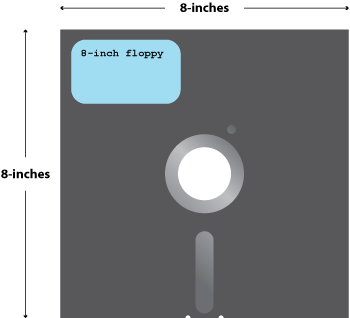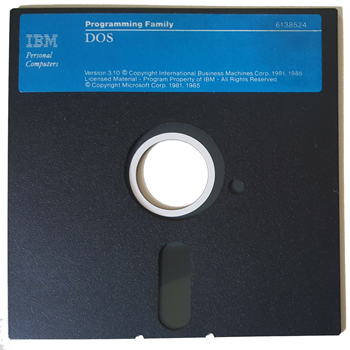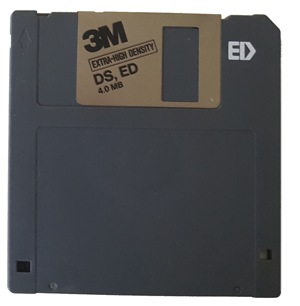I miss floppy disks. They serve as a reminder of when I first started to use a computer. I remember how spiffy the disks looked, the process of inserting a disk into a drive and snapping shut the door. It was truly a fun time — and apparently government employees at the Pentagon still use floppy disks to manage the United State’s nuclear weapons programs.
Yikes!
You can read about that interesting development on CNN’s website here. Because it’s been so long, however, I thought I’d review the floppy disk formats from days gone by.
8-inch Floppy Diskette

I remember seeing these diskettes at university, but I didn’t take any computer courses that used them. My first computer used the 5¼-inch diskettes, but at work I was the system administrator for our Microsoft Xenix system running on a TRS-80 Model 16 minicomputer. That system used 8-inch floppy diskettes. It was my job to backup the system on those diskettes as well as to install software updates. I’m rather disappointed that I didn’t filch any of the diskettes to keep for old time’s sake. Curse me for being an honest employee!
The 8-inch floppies originally stored 80KB of data. That’s 80 kilobytes or about 81,920 characters of information. Later formats could store up to 1.2MB of data, but by the time that improvement arrived, the 5¼-inch floppies were dominant. In fact, historically speaking, the 8-inch floppy era was rather brief, spanning only a short time in the 1970s and early 1980s. It makes sense that the US Government used them back then, but it doesn’t make sense that they still use them today.
5¼-inch Floppy Diskette

The 5¼-inch floppy was the one I used when I first started computing. I used it on the TRS-80 Model III and the Model 4P (a favorite), as well as my first IBM PC and other early PCs. The format was popular from 1978 through about 1987, when IBM stopped shipping PCs with the 5¼-inch floppy drives.
This diskette was known as the “floppy disk” for years because it was the only model available; the 8-inch diskettes were rarely used on microcomputers. Within the 5¼-inch world, however, several different standards existed: You had single-sided (SS) versus double-sided (DD) and single-density (SD) versus double-density (DD). Long story short, the typical 5¼-inch diskette originally held 360K of information, but toward the end of its lifespan the 1.2M formatted diskette was the norm.
3½-inch Floppy Diskette

When the Macintosh was introduced in 1984, it featured the 3½-inch, 720K floppy diskette. Compared with the 5¼-inch floppies, the 3½-inch model wasn’t really floppy, so some early Mac fanatics called it a “flexy disk.” I’m pleased that name didn’t stick. Anyway, when IBM introduced the PS/2 line in 1987, they also adopted the 3½-inch, 720K floppy, which rapidly became the standard: By 1990, the 5¼-inch floppy was pretty much gone.
Eventually, the 720K capacity was doubled to 1.44MB. That was the standard up until the early 2000s when optical discs effectively replaced floppy disks on all computers. And, of course, now optical discs are gone and SD cards and thumb drives are the standard for removeable media.
As a curious, historical note, the 4½-inch floppy pictured above is a rare ED disk. This format was introduced just at the end of the 3½-inch floppy’s reign. It was used on the old NeXT computers, but hardly any other system. The ED disks stored 4MB of information.
And, of course, today, the 3½-inch floppy disk remains as the universal “save” icon. So I suppose that some things don’t change.


I’m a Floppy Keeper more than user today, but the floppy drive was always with me growing up (& cassette tape..). They are useful for small things mind you with todays multi-meg forget about it! the reason why goverment particulary defense still use them is they typically have to transport small (around 6K) via sneaker net and only want a small storage format as the system typically virus scans any new media…
Comment by glennp — May 30, 2016 @ 3:04 am
Viruses and floppies was definitely an issue way back when. Remember the “games” that required you to boot the PC with a floppy in the drive? The PC naturally looked first to the floppy drive as the initial boot device. Therefore, the floppy with a free game became the most common vector. I wonder whether today’s BIOS would still look to a floppy drive to load the system?
Comment by admin — May 30, 2016 @ 7:57 am
From my fiddling I can say, Yes. You can still select the primary boot drive in AMI Bios to be A:, the lack of A: drive is not an issue as it waits for a time after it sends the wake up signal to the floppy port, no reply it goes to secondary boot device. SCARY!
Comment by glennp — May 30, 2016 @ 9:38 am
That’s just nuts!
Comment by admin — May 30, 2016 @ 7:39 pm